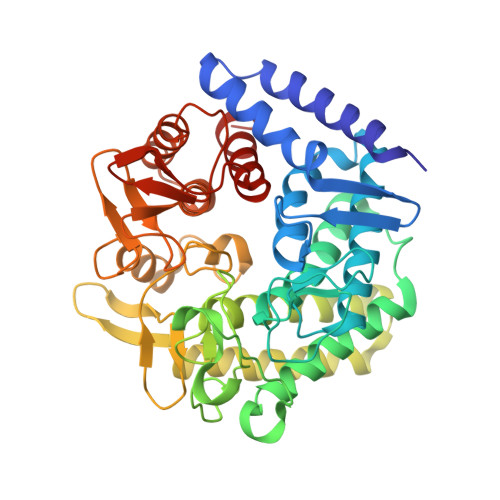Analysis of a New Family of Widely Distributed Metal-independent {alpha}-Mannosidases Provides Unique Insight into the Processing of N-Linked Glycans.
Gregg, K.J., Zandberg, W.F., Hehemann, J.H., Whitworth, G.E., Deng, L., Vocadlo, D.J., Boraston, A.B.(2011) J Biological Chem 286: 15586-15596
- PubMed: 21388958
- DOI: https://doi.org/10.1074/jbc.M111.223172
- Primary Citation of Related Structures:
3QPF, 3QRY, 3QSP, 3QT3, 3QT9 - PubMed Abstract:
The modification of N-glycans by α-mannosidases is a process that is relevant to a large number of biologically important processes, including infection by microbial pathogens and colonization by microbial symbionts. At present, the described mannosidases specific for α1,6-mannose linkages are very limited in number. Through structural and functional analysis of two sequence-related enzymes, one from Streptococcus pneumoniae (SpGH125) and one from Clostridium perfringens (CpGH125), a new glycoside hydrolase family, GH125, is identified and characterized. Analysis of SpGH125 and CpGH125 reveal them to have exo-α1,6-mannosidase activity consistent with specificity for N-linked glycans having their α1,3-mannose branches removed. The x-ray crystal structures of SpGH125 and CpGH125 obtained in apo-, inhibitor-bound, and substrate-bound forms provide both mechanistic and molecular insight into how these proteins, which adopt an (α/α)(6)-fold, recognize and hydrolyze the α1,6-mannosidic bond by an inverting, metal-independent catalytic mechanism. A phylogenetic analysis of GH125 proteins reveals this to be a relatively large and widespread family found frequently in bacterial pathogens, bacterial human gut symbionts, and a variety of fungi. Based on these studies we predict this family of enzymes will primarily comprise such exo-α1,6-mannosidases.
- Department of Biochemistry and Microbiology, University of Victoria, P.O. Box 3055 STN CSC, Victoria, British Columbia V8W 3P6, Canada.
Organizational Affiliation:

















